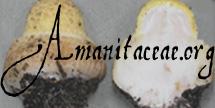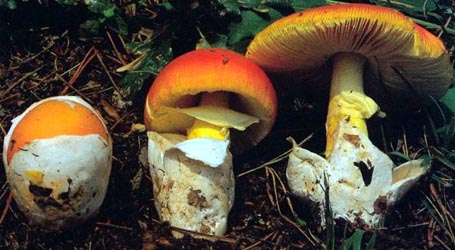

| name | Amanita arkansana |
| name status | nomen acceptum |
| author | H. R. Rosen |
| english name | "Arkansas Slender Caesar" |
| images |
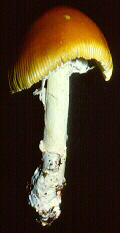  1. Amanita arkansana, Alachua Co., Florida, U.S.A. (RET 137-5) 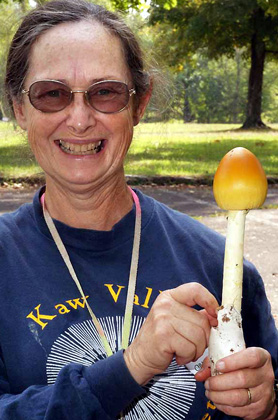  2. Amanita arkansana with Sherry Kaye (MOMA), ??, Missouri, U.S.A. 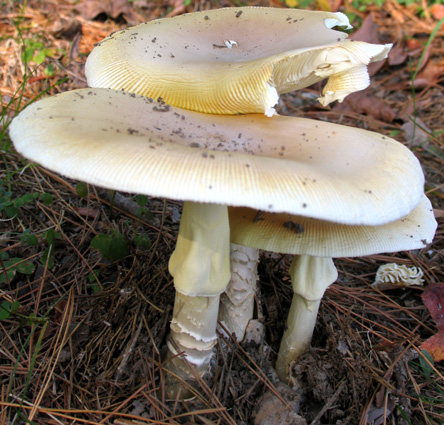  3. Amanita arkansana, after direct sun exposure, 8 km N of Bryant, Pulaski Co., Arkansas, U.S.A. (RET 136-6) 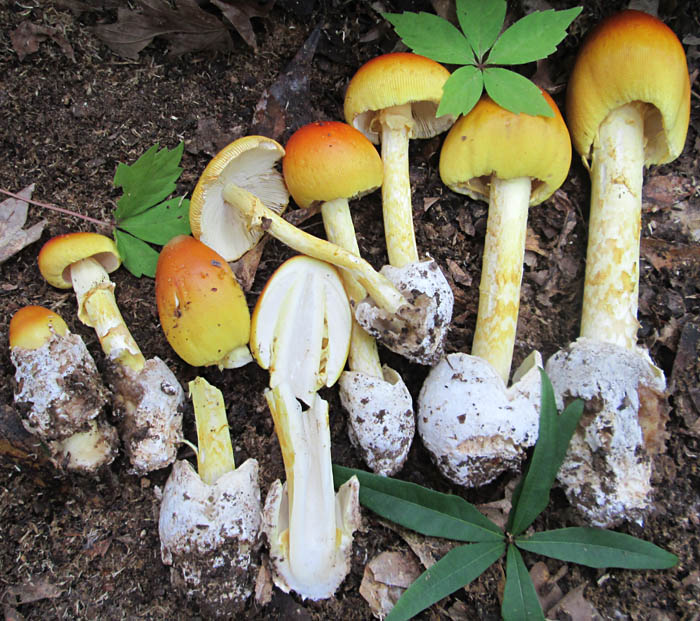  4. Amanita arkansana, Berkeley Lake, Gwinnett Co., Georgia, U.S.A. (RET 543-8) |
| cap |
The orange-brown to brownish yellow cap of A. arkansana measures up to 150 or more mm wide and has a strongly striate margin. |
| gills |
The gills are free (sometimes with a decurrent line, close to crowded, and fade from pale yellow to creamy white and (eventually) white as the mushroom ages. |
| stem |
Its stem is up to 175 × 30 mm or larger and is pallid, with pale yellow remains of a felted extension of the internal volval limb distributed below the white annulus. This latter stipe decoration becomes a deeper yellow or orange from handling. A white, membranous, saccate volva encloses the stipe base. |
| odor/taste | The odor is absent or faint to mild or somewhat sweetish. |
| spores |
The spores measure (7.0-) 7.7 - 11.4 (-15.0) × (5.6-) 6.0 - 8.0 (-10.2) µm and are broadly ellipsoid to ellipsoid (rarely subglobose or cylindric) and inamyloid. Clamps are present at bases of basidia. |
| discussion |
Amanita arkansana is easily distinguished from
Amanita
jacksonii Pomerl. by its white lamellae,
pallid stipe, and orange-brown pileus. Also,
A. arkansana often forms larger and very
fragile fruiting bodies.
Amanita
garabitoana Tulloss, Halling & G. M. Muell.
is a Central American species related to A.
arkansana. A Mexican species with
narrower spores and yellower cap than A.
garabitoana has recently been named
A.
hayalyuy Arora & Shepard.
Amanita
banningiana Tulloss nom. prov. is a
smaller species, with a cap at first bright yellow,
becoming orange-brown from the center outward
through development; its stem is yellow with
subfelted yellow fragments of the part of the volva
originally present between the ring and the stem''s
surface in the developing "button." The reader
may also wish to check
A.
cahokiana. Amanita arkansana was originally described from the state for which it is named and occurs throughout the southeastern U.S.A. It is associated with pine and oak.—R. E. Tulloss |
| brief editors | RET |
| name | Amanita arkansana | ||||||||||||||||||||||||||||||||||||||||||||||||||||||||||||||||||||||||||||||||||||||||||||||||||||||||||||||||||||||||||||||||||||
| author | H. R. Rosen. 1926. Mycologia 18: 97, pl. 9-11. | ||||||||||||||||||||||||||||||||||||||||||||||||||||||||||||||||||||||||||||||||||||||||||||||||||||||||||||||||||||||||||||||||||||
| name status | nomen acceptum | ||||||||||||||||||||||||||||||||||||||||||||||||||||||||||||||||||||||||||||||||||||||||||||||||||||||||||||||||||||||||||||||||||||
| english name | "Arkansas Slender Caesar" | ||||||||||||||||||||||||||||||||||||||||||||||||||||||||||||||||||||||||||||||||||||||||||||||||||||||||||||||||||||||||||||||||||||
| etymology | Arkansas + -ana, suffix indicating possession; hence, "of Arkansas" | ||||||||||||||||||||||||||||||||||||||||||||||||||||||||||||||||||||||||||||||||||||||||||||||||||||||||||||||||||||||||||||||||||||
| MycoBank nos. | 203697 | ||||||||||||||||||||||||||||||||||||||||||||||||||||||||||||||||||||||||||||||||||||||||||||||||||||||||||||||||||||||||||||||||||||
| GenBank nos. |
Due to delays in data processing at GenBank, some accession numbers may lead to unreleased (pending) pages.
These pages will eventually be made live, so try again later.
| ||||||||||||||||||||||||||||||||||||||||||||||||||||||||||||||||||||||||||||||||||||||||||||||||||||||||||||||||||||||||||||||||||||
| lectotypes | BPI (provisional per RET); isolectotype, TENN | ||||||||||||||||||||||||||||||||||||||||||||||||||||||||||||||||||||||||||||||||||||||||||||||||||||||||||||||||||||||||||||||||||||
| lectotypifications | proposed herein | ||||||||||||||||||||||||||||||||||||||||||||||||||||||||||||||||||||||||||||||||||||||||||||||||||||||||||||||||||||||||||||||||||||
| type studies | double click in markup mode to edit. | ||||||||||||||||||||||||||||||||||||||||||||||||||||||||||||||||||||||||||||||||||||||||||||||||||||||||||||||||||||||||||||||||||||
| revisions | Tulloss, here. | ||||||||||||||||||||||||||||||||||||||||||||||||||||||||||||||||||||||||||||||||||||||||||||||||||||||||||||||||||||||||||||||||||||
| selected illustrations | Justice, J. 1984. Arkansas Naturalist 2(5): cover, 2. | ||||||||||||||||||||||||||||||||||||||||||||||||||||||||||||||||||||||||||||||||||||||||||||||||||||||||||||||||||||||||||||||||||||
| intro |
The following text may make multiple use of each data field. The field may contain magenta text presenting data from a type study and/or revision of other original material cited in the protolog of the present taxon. Macroscopic descriptions in magenta are a combination of data from the protolog and additional observations made on the exiccata during revision of the cited original material. The same field may also contain black text, which is data from a revision of the present taxon (including non-type material and/or material not cited in the protolog). Paragraphs of black text will be labeled if further subdivision of this text is appropriate. Olive text indicates a specimen that has not been thoroughly examined (for example, for microscopic details) and marks other places in the text where data is missing or uncertain. The following material not directly from the protolog of the present taxon is based upon molecular studies of Santiago Sanchez-Ramírez and a type study and orther original research of R. E. Tulloss. | ||||||||||||||||||||||||||||||||||||||||||||||||||||||||||||||||||||||||||||||||||||||||||||||||||||||||||||||||||||||||||||||||||||
| pileus | 75 - 150+ mm wide, Orange-Buff (8.5YR 7.2/9.0) or Baryta Yellow (5Y 8.4/6.0) or 10YR 6/10 or deep orange or brownish red or brownish yellow (e.g., approximately 6B-D7-8 or 8C8) over disc, pale yellow to Lemon Yellow or yellow or orange-yellow (e.g., 4A5 or 4A8) or Light Cadmium yellow (2.5Y 7.5/10) near margin, never red or orange-red, sometimes virgate in central region, fading extensively in direct sunlight, otherwise unchanging when cut or bruised, subovoid at first, then hemispheric to rounded conic (sometimes with broad umbo), becoming convex to planoconvex to concave and (eventually) distinctly umbonate, subshiny, tacky or barely viscid, becoming dry; context white to pale yellow (1A2) except near pileipellis and near lamellae (in these regions always more intensely yellow than elsewhere), unchanging when cut or bruised, 4 - 9.5 mm thick, thinning evenly for one third to one half radius, then membranous to margin; margin conspicuously striate (0.4 - 0.5R), nonappendiculate; universal veil usually absent, rarely as one or two large white membranous patches. | ||||||||||||||||||||||||||||||||||||||||||||||||||||||||||||||||||||||||||||||||||||||||||||||||||||||||||||||||||||||||||||||||||||
| lamellae | free or adnexed by decurrent line short or extending 10 - 20 mm down stipe apex, sometimes with decurrent tooth, close to crowded, yellow to cream in mass, in side view yellow at first (especially near edge and near context), then fading to very pale yellow (1A2) and then to creamy white or off white to white, unchanging when cut or bruised, 5 - 15 mm broad, with broadest point nearer pileus margin than stipe, sometimes with fimbriate and yellow or yellowish edge; lamellulae rounded truncate to subtruncate to subattenuate, apparently not frequent. | ||||||||||||||||||||||||||||||||||||||||||||||||||||||||||||||||||||||||||||||||||||||||||||||||||||||||||||||||||||||||||||||||||||
| stipe | 100 - 174 × 12.5 - 30 mm, whitish to pale yellow (e.g., 3A3) to yellow, often more intensely colored above partial veil, narrowing upward slightly, flaring very slightly at apex, finely longitudinally striatulate, usually with irregular patches or fibrils in upper half, with patches and fibrils concolorous at first and becoming deeper yellow (e.g., 4A3-4) to tan to orange when handled; context white to cream or pale yellow nearest exterior surface fading to nearly white adjacent to central cylinder, unchanging when cut or bruised, with larva tunnels concolorous, stuffed with white cottony material, becoming hollow, with central cylinder 7 - 15± mm wide; partial veil subapical to superior (e.g., attached 19± mm below apex), membranous, yellow (e.g., 3A3), often more intensely colored on underside, large (up to 40 mm long), pendent, persistent, collapsing, sometimes tearing, with striate upper surface, with underside bearing patches and fibrils similar to those decorating stipe; universal veil as ample saccate volva, soft-leathery (like kid leather), grayish white to white on the exterior , with inner surface often pale yellow (orangish brown and sometimes peeling or flaking off rather easily in some exsiccata), membranous, rather thick (1.5 - 10 mm at mid-height of limb), rounded below, 30 - 60 (-110) × 32± - 80 mm, only attached near very base of stipe in mature specimens, with limbus internus small,white to pale yellow-orange, thin to rather thick, attached less than one third of way from stipe base to top of limb. | ||||||||||||||||||||||||||||||||||||||||||||||||||||||||||||||||||||||||||||||||||||||||||||||||||||||||||||||||||||||||||||||||||||
| odor/taste | Odor absent or faint to mild or somewhat sweetish. Taste not recorded. | ||||||||||||||||||||||||||||||||||||||||||||||||||||||||||||||||||||||||||||||||||||||||||||||||||||||||||||||||||||||||||||||||||||
| macrochemical tests |
Spot test for laccase (syringaldazine) - negative throughout basidiome. Spot test for tyrosinase (L-tyrosine) - scattered positive reactions—strong on surface of volva and spots in stipe base context after 3 - 4 min., strong reaction throughout volva after 9± min., faint in very limited region(s) on upper stipe context or surface after 8 - 20 min., faint on limited region(s) of pileus after 18 - 40 min. Test vouchers: Tulloss 10-26-85-A, Tulloss 7-16-87-C. | ||||||||||||||||||||||||||||||||||||||||||||||||||||||||||||||||||||||||||||||||||||||||||||||||||||||||||||||||||||||||||||||||||||
| pileipellis | (70-) 95 - 250 µm thick, with colorless and largely gelatinized suprapellis scant or up to 45 µm thick, with pale yellowish to yellow to orangish yellow to orange-yellow subpellis (70-) 95 - 230 µm thick, mostly ungelatinized; filamentous, undifferentiated hyphae 2.0 - 7.7 µm wide, in fascicles or singly, interwoven over disc, subradially arranged and more densely packed elsewhere; vascular hyphae 2.8 - 16.1 µm wide, occasionally branching, sinuous, scattered to locally common. | ||||||||||||||||||||||||||||||||||||||||||||||||||||||||||||||||||||||||||||||||||||||||||||||||||||||||||||||||||||||||||||||||||||
| pileus context | filamentous, undifferentiated hyphae 2.2 - 11.2 µm wide, branching, plentiful, in broad fascicles and singly, interwoven in moderately open lattice, occasionally with yellowish subrefractive walls; acrophysalides plentiful, thin-walled, ovate to clavate to narrowly clavate to subfusiform, sometimes subrostrate or rostrate, up to 200+ × 56 µm; vascular hyphae 10.5 - 21 µm wide, scattered, sinuous. | ||||||||||||||||||||||||||||||||||||||||||||||||||||||||||||||||||||||||||||||||||||||||||||||||||||||||||||||||||||||||||||||||||||
| lamella trama | bilateral, badly collapsed and only poorly rehydrating in isotype; wcs = 35 - 65 µm; subhymenial base of curved elongated cells, singly or in short chains, most or all intercalary, up to 56 × 21 µm, overlapping both subhymenium and central stratum, with admixture of occasional filamentous, undifferentiated hyphae; filamentous, undifferentiated hyphae 2.2 - 3.5 µm wide, with partially inflated intercalary segments up to 16.5 µm wide in central stratum; terminal, divergent inflated cells not observed; vascular hyphae not observed. | ||||||||||||||||||||||||||||||||||||||||||||||||||||||||||||||||||||||||||||||||||||||||||||||||||||||||||||||||||||||||||||||||||||
| subhymenium | collapsed in type material, with parameters not accurately measurable (wst-near probably > 75 µm; wst-far probably ≤ 85 µm) in isotype; from recent collections (wst-near = 75 - 110 µm; wst-far = 95 - 125 µm); mixture of inflated cells and partially inflated or uninflated short hyphal segments, pseudoparenchymatous in some regions, with one to three cells between subhymenial base and nearest bases of basidia/-oles, with basidia arising from cells of all types. | ||||||||||||||||||||||||||||||||||||||||||||||||||||||||||||||||||||||||||||||||||||||||||||||||||||||||||||||||||||||||||||||||||||
| basidia |
In isotype: mostly collapsed, (up to 55±
× 12.2- - 13.5+ µm). In non-type material: 39 - 57 × 9.0 - 13.8 µm, thin-walled, dominantly 4-, but also 3-, 2-, and 1-sterigmate, with sterigmata up to 6.5 × 3.0 µm (commonly quite slender); clamps occasional to rather common (especially in region of lamella with no mature basidia), prominent. | ||||||||||||||||||||||||||||||||||||||||||||||||||||||||||||||||||||||||||||||||||||||||||||||||||||||||||||||||||||||||||||||||||||
| universal veil | On pileus: absent. On stipe base, exterior surface: sometimes partially gelatinized, with interior visible through plentiful gaps; filamentous, undifferentiated hyphae 1.5 - 8.5 µm wide, branching, dominant, singly and in narrow and broad fascicles, interwoven loosely, without dominant orientation, with some partially to strongly gelatinized, sometimes making loose coil, occasionally with yellowish subrefractive walls; vascular hyphae not observed. On stipe base, interior: mostly colorless or pale yellowish, but with brownish orange zone parallel to and a little below the exterior surface (occupying region between 5% and 10% of distance from outer surface to inner surface in well-preserved limb fragment, with similar region seen in other mounts of older limbs not very well rehydratable), with outermost 30±% of thickness rehydrating most poorly; filamentous, undifferentiated hyphae 1.5 - 9.8 µm wide, branching, plentiful to locally dominant, in fascicles and singly, often coiling, interwoven in loose lattice, occasionally with yellowish subrefractive and slightly thickened walls; inflated cells plentiful to locally dominant (apparently in clusters) especially in region away from exterior surface, terminal, with walls thin or up to 0.5 µm thick, subglobose to pyriform to broadly ovoid to broadly ellipsoid (up to 85 × 65 µm) and ellipsoid to clavate to narrowly clavate (up to 78 × 46 µm); vascular hyphae not observed; clamps common. On stipe base, inner surface: elements like those of interior collapsed and strongly gelatinized in layer 10 - 35 µm thick, colorless to golden yellow (in isotype). | ||||||||||||||||||||||||||||||||||||||||||||||||||||||||||||||||||||||||||||||||||||||||||||||||||||||||||||||||||||||||||||||||||||
| stipe context | longitudinally acrophysalidic; filamentous, undifferentiated hyphae 3.8 - 11.9 µm wide, branching, plentiful to dominant (near surface), in fascicles and singly; acrophysalides dominant away from surface, thin-walled, often broad and rounded at base, up to 145 × 48 µm; vascular hyphae 2.8 - 21 µm wide, scattered, sinuous, infrequently coiled or twisted. | ||||||||||||||||||||||||||||||||||||||||||||||||||||||||||||||||||||||||||||||||||||||||||||||||||||||||||||||||||||||||||||||||||||
| partial veil | gelatinized somewhat on surfaces; filamentous, undifferentiated hyphae 1.5 - 7.4 µm wide, branching, dominating, singly and in fascicles, with numerous fascicles coparallel and subradial (with interweaving single hyphae and fascicles between them), closely packed, occasionally with yellowish subrefractive walls; inflated cells terminal, subfusiform to narrowly clavate to clavate to ellipsoid (up to 109 × 39 µm), thin-walled, relatively common; vascular hyphae 3.8 - 16.1 µm wide, sinuous, occasionally loosely tangled locally, scattered to locally rather common. | ||||||||||||||||||||||||||||||||||||||||||||||||||||||||||||||||||||||||||||||||||||||||||||||||||||||||||||||||||||||||||||||||||||
| lamella edge tissue | sterile. | ||||||||||||||||||||||||||||||||||||||||||||||||||||||||||||||||||||||||||||||||||||||||||||||||||||||||||||||||||||||||||||||||||||
| basidiospores | composite of data from all material revised by RET & CRC: [240/11/6] (7.0-) 7.7 - 10.5 (-15.0) × (5.6-) 6.0 - 8.0 (-10.2) µm, (L = (8.0-) 8.3 - 9.9 µm; L’ = 8.9 µm; W = (6.3-) 6.5 -7.3 µm; W’ = 6.9 µm; Q = (1.10-) 1.18 - 1.43 (-1.69); Q = (1.22-) 1.24 - 1.38; Q’ = 1.30), hyaline, colorless, smooth, thin-walled, inamyloid, broadly ellipsoid to ellipsoid, rarely subglobose, rarely elongate, often at least somewhat adaxially flattened, rarely as "giant spores"; apiculus sublateral, cylindric to narrowly truncate-conic, usually relatively small, sometimes proportionately broad; contents granular to mono- or occasionally multiguttulate with additional small granules; white in deposit. | ||||||||||||||||||||||||||||||||||||||||||||||||||||||||||||||||||||||||||||||||||||||||||||||||||||||||||||||||||||||||||||||||||||
| ecology | Solitary to scattered or (occasionally) in troops. Arkansas: In frondose woods or in mixed woods (probably near Quercus). Florida: In coarse sand under Pinus clausa. Mississippi: In damp, sandy loam of river bottom, in forest of Quercus nigra, Q. phellos, and P. echinata with Nyssa sylvatica, Ilex sp., Carpinus caroliniana, and Liquidambar styraciflua. Texas: In mixed Pinus-hardwood forest. | ||||||||||||||||||||||||||||||||||||||||||||||||||||||||||||||||||||||||||||||||||||||||||||||||||||||||||||||||||||||||||||||||||||
| material examined |
<U.S.A.:
ARKANSAS—Pulaski Co. - Little Rock,
Arkansas Dept. of Pollution Control & Ecology,
14.vi.1994 Jay Justice s.n.
(RET 136-6); unkn. loc.,
5.vii.1983 J. Justice s.n. [Tulloss 7-5-83-JJ2]
(RET 059-3). Saline Co. - 25 mi W of Little
Rock, 5.vi.1981 J. Justice s.n.
[Tulloss 6-5-81-JJ1] (RET 059-4).
Washington[?] Co. - E of
Fayetteville, E of Mt. Sequoia, | ||||||||||||||||||||||||||||||||||||||||||||||||||||||||||||||||||||||||||||||||||||||||||||||||||||||||||||||||||||||||||||||||||||
| discussion |
Rosen had the opportunity to compare A. arkansana with a red-capped species (possibly A. jacksonii) in the field and found that the two taxa were never intermixed and that the colors of the pilei of the two taxa were constant from "button" to mature basidiome and that no intergrading of colors was to be found. He also notes that the volval sac is larger in A. arkansana than in the red-capped species and that the lamellae of A. arkansana becoming distinctly whiter than those of the red-capped species in mature basidiomes. The isotype in BPI is composed of two specimens reduced to fragments: One specimen is mature, but very poorly dried or dried in senescence; the other is immature. The date on the BPI isotype packet results from an apparent slip of the pen. A handwritten label in the packet identifies the material as "ex type" and bears the year "1926"; however, the protolog clearly states that the holotype collection was made on 13 October 1925. The isotype in TENN comprises several stipe bases and a few pileal fragments. Annotation indicates that this is duplicate material extracted from the BPI isotype. Rosen was a member of the faculty of the Department of Plant Pathology, University of Arkansas, Fayetteville. Therefore, an effort was made to find the holotype of A. arkansana in both UARK and the herbarium of the Plant Pathology Department. The holotype was not to be found in either institution, and apparently it is lost. Therefore, a lectotype should be designated. Because of the more thorough and abundant representation of all parts of the basidiomes, I plan to designate the isotype in BPI as the lectotype of this species (ICBN §7.4). It is also noteworthy the material at BPI is the material that was reviewed by Gilbert (1941). Dr. Jay Justice, Mr. David Lewis, and Mr. Aaron Norarevian have kindly given me several recent collections of A. arkansana from which additional data on this species has been extracted. This species is assignable to Amanita stirps Hemibapha and can be distinguished from other taxa within that stirpes by key here [PDF]. The specimen with the largest value of Q was a specimen with rather common giant spores occurring on 1- and 2-sterigmate basidia. For purposes of comparison, spore data (green figure) from A. banningiana are presented here: For purposes of comparison, spore data (red figure) from A. cahokiana are presented here: | ||||||||||||||||||||||||||||||||||||||||||||||||||||||||||||||||||||||||||||||||||||||||||||||||||||||||||||||||||||||||||||||||||||
| citations | —R. E. Tulloss | ||||||||||||||||||||||||||||||||||||||||||||||||||||||||||||||||||||||||||||||||||||||||||||||||||||||||||||||||||||||||||||||||||||
| editors | RET | ||||||||||||||||||||||||||||||||||||||||||||||||||||||||||||||||||||||||||||||||||||||||||||||||||||||||||||||||||||||||||||||||||||
Information to support the viewer in reading the content of "technical" tabs can be found here.
| name | Amanita arkansana |
| name status | nomen acceptum |
| author | H. R. Rosen |
| english name | "Arkansas Slender Caesar" |
| images |
  1. Amanita arkansana, Alachua Co., Florida, U.S.A. (RET 137-5)   2. Amanita arkansana with Sherry Kaye (MOMA), ??, Missouri, U.S.A.   3. Amanita arkansana, after direct sun exposure, 8 km N of Bryant, Pulaski Co., Arkansas, U.S.A. (RET 136-6)   4. Amanita arkansana, Berkeley Lake, Gwinnett Co., Georgia, U.S.A. (RET 543-8) |
| photo |
RET - (1) Alachua County, Florida, U.S.A. (RET 137-5) John Rapp - (2) unknown locality, Missouri, U.S.A. Jay Justice - (3) 4-H Nature Center, 8 km north of Bryant, Pulaski County, Arkansas, U.S.A. (RET 136-6) Jimmy Caine - (5) Berkeley Lake, Gwinnett County, Georgia, U.S.A. (RET 543-8) [Note: Original image can be found on www.mushroomobserver.org observation #137525. |
| name | Amanita arkansana |
| bottom links |
[ Keys & Checklist/Picturebooks ] [ Great Smoky Mtns. N.P. & region list ] [ E. Texas & Gulf Coast list ] [ Draft description of, & key to, sect. Caesareae ] |
| name | Amanita arkansana |
| bottom links |
[ Keys & Checklist/Picturebooks ] [ Great Smoky Mtns. N.P. & region list ] [ E. Texas & Gulf Coast list ] [ Draft description of, & key to, sect. Caesareae ] |
Each spore data set is intended to comprise a set of measurements from a single specimen made by a single observer; and explanations prepared for this site talk about specimen-observer pairs associated with each data set. Combining more data into a single data set is non-optimal because it obscures observer differences (which may be valuable for instructional purposes, for example) and may obscure instances in which a single collection inadvertently contains a mixture of taxa.

